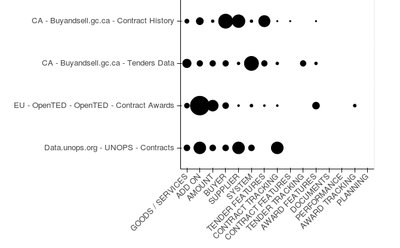Creating the Open Contracting Data Standard

I managed to have a quick chat with Sarah Bird on the day the Open Contracting Data Standard went live. Sarah has played a significant role in the planning, creation and now the implementation stages of the data standard. I managed to find out a little more about what the standard is, and how it works.
So Sarah, what is Open Contracting?
To understand the standard, you need to know that the Open Contracting Partnership is a group that exists to promote open contracting, which is the practice of having complete disclosure and participation in all contracting process in public procurement space.
Partnership between the groups involved exists on an advocacy level, and rests on a set of principles: that the government will be open; publish information in a timely manner; and include all stakeholders. However, a big part of this rests in disclosing information, and there is a missing piece of the puzzle if there is no way to do this. In response to this issue the World Bank portion of the Open Contracting Partnership, alongside Omidyar funded the Web Foundation to write a data standard for public contracting data, and they contacted Aptivate to be the technical lead.
What has your role been in creating the standard?
Myself and Tim Davis from Web Foundation/Practical Participation were lead authors on the data standard. Mark from Aptivate was also a big help, he managed the relationship with the Web Foundation. Tim and I wrote the documentation and the schema release, which is a description of a whole bunch of fields, that when put together can describe a contracting process.
How did you go about the work?
I was more involved in the supply side; we surveyed 30 governments and the data they were disclosing. Then we built a site called Contracting Data Comparison to use as a repository of the data collected. We looked at 38 data sets and then synthesised the research. This meant looking at lots of spreadsheets and contracting data to come up with visualizations showing different types of datasets. We then came up with this draft standard combining supply and demand research.
Why is a standard so important?
A standard is generally needed to make data compatible. In addition, it enables the reuse of tools. Governments are not necessarily going to have the resources to build tools for each set of data they want to look at. With a data standard, tools can be reused which is really useful, particularly for low-resource governments and countries.
Additionally, at the moment data is incompatible – we cannot compare data between different places because data is not comparable over time and place. But open standard helps to be able to compare within local provinces or even globally. For example, finding out why building a road would cost more in country X than in country Y. Another thing it can be used as is an advocacy tool to help governments climbing the ladder of transparency.
Where is the standard going next?
Open partnership has recently established an independent body that exists to do open contracting. The standard will live inside the board. This is good - it is how it should be, as it means increased participation and transparency. I hope that the standard will continue to evolve and it will have a community around it that cares not only about evolving but also improving it.
What could Aptivate's role be in helping the standard advance?
For Aptivate, a standard is nothing if it is not implemented, so my hope is that Aptivate gets involved in helping civil society or governments to actually implement open contracting the data standard. Helping them understand how to translate their data, as well as what it means. Or for a civil society perspective, we need to help people produce the data, as well as use the data for advocacy or whatever they want to use it for. This could be done with data visualization, for example the one we have created recently TradeMapper.
